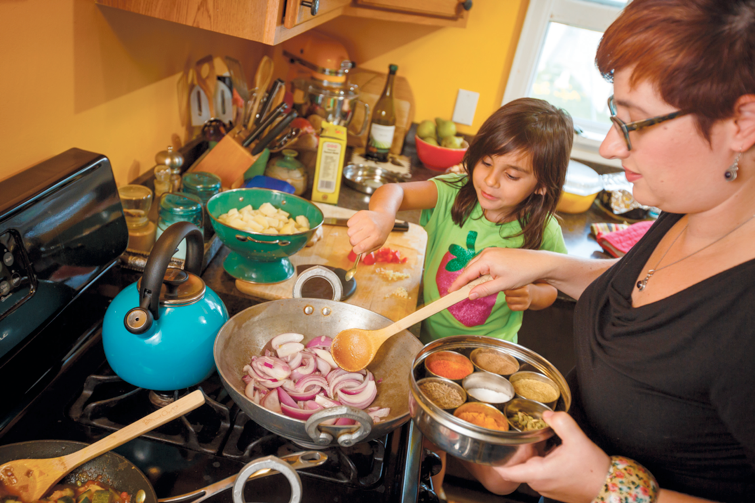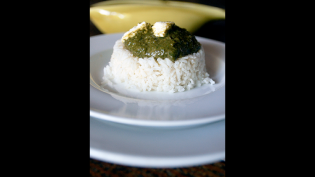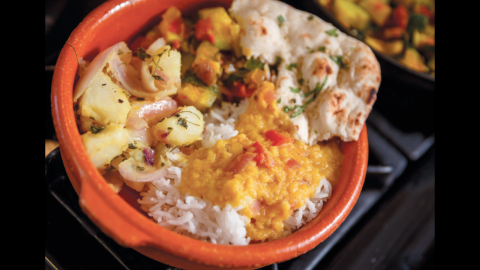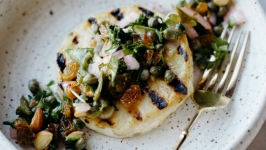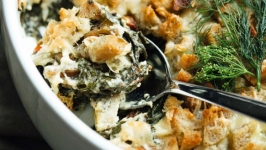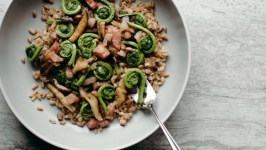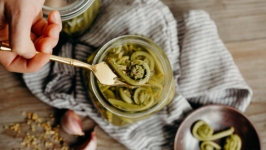Currying Favor: A Love Story
Until I met my husband, a native of India, my culinary boundaries did not include that far-off subcontinent. So when I decided to dip my spoon into the seemingly complicated jar of exotic spices, colorful lentils and unfamiliar herbs, I had no expectation other than to master the cooking of vegetables to that delectable state of softness.
A tough task, indeed, for this keep-the-veggies-crunchy kind of cook. Oh, and hold the spicy, please?
It was my charge to re-create the taste of home for him and to somehow lure this Indian expat to find my cooking sustainable for a lifetime. Challenged, I put my coffee-grinder-turned-spice-grinder to work overtime and cookbooks piled up with endlessly complicated recipes earmarked to try. I produced a lot of dishes without being able to gauge how they were supposed to taste.
My polite better half choked down over-spiced chickpeas and creamed greens with a weak smile and Indian head wobble. At least he appreciated my effort.
Yet, phone calls to aunties and discussions in rapid-fire Hindi with family in Delhi resulted in a minor war and a reluctant kitchen takeover. I exchanged cookbooks for simple suggestions, scribbled on scraps of paper, with no accurate measurements or semblance of order. What bubbled up first was a simple dal—a typical North Indian staple of soupy lentils, generally eaten daily with white basmati rice and a couple of rotis (traditional whole-wheat flatbread).
Fast forward a few trips to India, a Hindu wedding, kids and some pivotal cooking lessons with my mother-in-law, and I began to notice a pattern in these home-cooked concoctions: Pick a vegetable and/or lentil and finish it off with a tadka to give it a signature flavor profile—usually a unique blend of tempered spices combined (or not) with red onion, tomato, ginger, garlic, coconut, and so forth, depending upon the recipe, the region of India from which it came, and your imagination.
But, like my marriage of seven years, Indian cooking is not quite that simple. It’s taken almost a decade of perseverance and patience by both of us to not argue over the consistency of the dal, the amount of onions and tomatoes in the tadka or how to brew a simple cup of chai tea.
And even though I can make a piecrust with my eyes blindfolded, I have yet to master the art of rolling a delicate roti and toasting or cooking it without somehow sending it up in flames. Those are the times I just throw in the towel and realize that we need to work together to get what we both want: fresh, tasty Indian food.
So on rainy days when my husband waxes nostalgic for his mom’s veggie pakoras, we’re side by side slicing onions, potatoes and zucchini and dipping them in chickpea batter, then eating them up as fast as we fry them. Often we roast Cream of Wheat and make a sweet halwa to give as a prasad (offering) at the local Hindu temple. And when I come home from my Saturday grocery shopping with a bag of piping-hot fresh samosas, we both chuckle over the fact I have not yet tried my luck at that savory treat.
Eventually, I’ll attempt making samosas. And maybe someday I’ll get my kids to gobble them down dipped in coriander (cilantro) chutney. Someday. For now, I just have to be content that my earnest efforts at cooking Indian food have helped blend our two cultures, which of course, has been my motive all along.
Just like taking trips up to Michigan to pick fruit as our American family tradition, it has become equally important to teach our kids the proper way to eat a mango and to make our pilgrimage up to Chicago’s Devon Street to eat chaat and jalebi and teach our kids about their Indian food heritage. Because at this point, I don’t think it’s about impressing my husband with my cooking abilities anymore. It’s about keeping my family and our blended cultures, nourished.
Sources
Our family shops at the Indian grocery store located in the India Garden Restaurant, 615 West Edison Road, Mishawaka, Indiana. They have a nice selection of flours, dals and spices, as well as a refrigerated section that has specialty produce, such as curry leaves and fresh fenugreek. They also carry frozen goat meat, frozen naan breads and kulfi (Indian ice cream).
Cleveland Super Stop at 17963 Cleveland Road (corner of Cleveland and Ironwood) has a nice selection of Indian and Middle Eastern groceries. This little shop also has terrific samosas on Saturday mornings, if you get there early enough.
When in Chicago, try the many Indian shops along West Devon Street, especially the Patel Brothers grocery store, located at 2610 West Devon Street (PatelBros.com). Everything you want to stock your kitchen can be found there, included bulk savory snacks, native Indian vegetables and herbs and specialty items.


